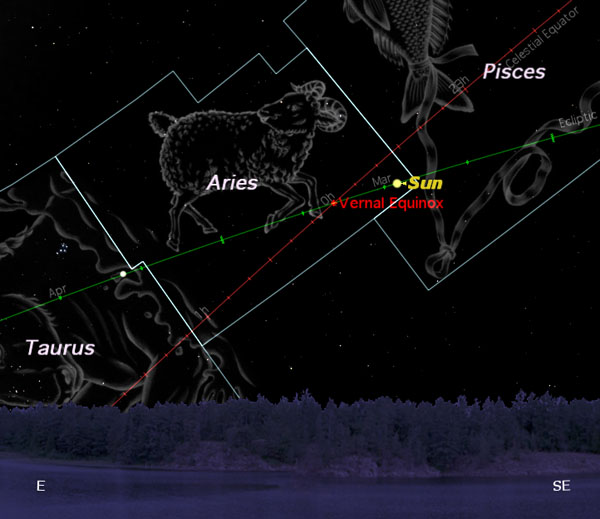 |
|
|
|
|

Your Astrological Sign May Not Be What You Think It Is
It's a great conversation starter: "What's your sign?"
But before you ask or answer that question, consider this: your zodiac sign corresponds to the position of the sun relative to constellations as they appeared over 2200 years ago!
The science behind astrology may have its roots in astronomy but don’t confuse these two disciplines. Astronomy can explain the position of the stars in the sky but it’s up to you to determine what, if anything, their alignment signifies.
The Constellations of the Zodiac
The ecliptic, or the position of the Sun as it’s perceived from the revolving Earth, passes through the constellations that formed the Zodiac - Aries, Taurus, Gemini, Cancer, Leo, Virgo, Libra, Scorpio, Sagittarius, Capricorn, Aquarius and Pisces. Zodiac signs were originally determined by which constellation the Sun was "in" on the day you were born.
Early astronomers observed the Sun traveling through the signs of the Zodiac in the course of one year, spending about a month in each. Thus, they calculated that each constellation extends 30 degrees across the ecliptic.
However, a phenomenon called precession has altered the position of the constellations we see today.
Precession and Astrology
The first day of spring in the Northern Hemisphere was once marked by the zero point of the Zodiac. Astronomers call this the vernal equinox and it occurs as the ecliptic and celestial equator intersect.
Around 600 BCE, the zero point was in Aries and was called the "first point of Aries." The constellation Aries encompassed the first 30 degrees of the ecliptic; from 30 to 60 degrees was Taurus; from 60 to 90 degrees was Gemini; and so on for all twelve constellations of the Zodiac.
Unbeknownst to the ancient astrologers, the Earth continually wobbles around its axis in a 25,800-year cycle. This wobble—called precession—is caused by the gravitational attraction of the Moon on Earth's equatorial bulge.
Over the past two-and-a-half millennia, this wobble has caused the intersection point between the celestial equator and the ecliptic to move west along the ecliptic by 36 degrees, or almost exactly one-tenth of the way around. This means that the signs have slipped one-tenth—or almost one whole month—of the way around the sky to the west, relative to the stars beyond.
For instance, those born between March 21 and April 19 consider themselves to be Aries. Today, the Sun is no longer within the constellation of Aries during much of that period. From March 11 to April 18, the Sun is actually in the constellation of Pisces!
Your "Real Sign"
The table below lists the dates when the Sun is actually within the astronomical constellations of the Zodiac, according to modern constellation boundaries and corrected for precession (these dates can vary a day from year to year).
You will most likely find that once precession is taken into account, your zodiac sign is different. And if you were born between November 29 and December 17, your sign is actually one you never saw in the newspaper: you are an Ophiuchus! The eliptic passes through the constellation of Ophiuchus after Scorpius.
Now you really have something cool with which to start that conversation!
Check out your “real” zodiac sign below and see what the sky looked like on your birthday by going to the Birthday Sky application.
Capricorn - Jan 20 to Feb 16
Aquarius - Feb 16 to Mar 11
Pisces - Mar 11 to Apr 18
Aries - Apr 18 to May 13
Taurus - May 13 to Jun 21
Gemini - Jun 21 to Jul 20
Cancer - Jul 20 to Aug 10
Leo - Aug 10 to Sep 16
Virgo - Sep 16 to Oct 30
Libra - Oct 30 to Nov 23
Scorpius - Nov 23 to Nov 29
Ophiuchus - Nov 29 to Dec 17
Sagittarius - Dec 17 to Jan 20 |
  Article © News, Technology, Space, Science - Breaking News and interesting storiesShare |
|
|
|
|
You need to login first |
|
|
|
|

Satellite Shooted down |
|
|
|
|
 |
|
 |
| |
Did you know?...
- Women in ancient Egypt prevented pregnancy with plugs made of crocodile droppings?
- Based on artifacts and cave paintings, Ice Age women were likely to enjoy sex as much as their male mates?
- In 2005, the average first time for US girls occurred at the age of 17?
- Known aphrodisiacs of the food world include chocolate, oysters and spicy foods?
- That females have a weaker sex drive than men is a cultural misconception?
- The most common sexual problem among men is premature ejaculation?
- It is a common misconception that pregnancy can’t occur without male orgasm?
- Whether put to use or not, males produce about 300 million sperm every day?
|
|
 |
|
 |
|
